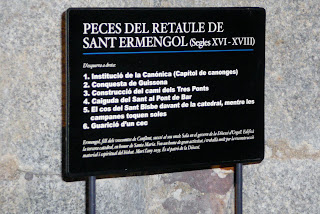La Seu derives from the Latin for "seat" and means, by derivation, a Cathedral, so, the Cathedral of Urgell. It houses early historical and more current historical memorials, including this for martyrs of the religious persecutions of the Spanish Civil War. It also is revered for its place in the martyrdom of the Cathars in the Pope's Albigensian Crusades in the nearby Languedoc, France, but spilling over boundaries into what is now Spain, see http://www.museuepiscopalvic.com/laprincesasavia/eng/ambit2.2.htm/. Religious paintings after that era tout the now unchallenged dogma that the Cathars had opposed so strongly.
Is this representing Saint Ermengol? He was Bishop of La Seu D'Urgell 1015-1035, and the Cathedral's patron saint. This is a cenotaph, not an actual burial place, I understand. There are six gilt panels, not all could fit, thus the two photos.
The panel fourth from left, resembles the pillage of Carcassonne, Albigensian Crusade as seen in other paintings, but that may be the result of suggestion, knowing that Cathar sympathizers in clergy and lay tried to find refuge here, and failed.
Josep Tapies Sirvantand six other Priests of the Diocese (Joseph Tàpies Sirvant; Pascal Araguás Guárdia; Silvester Arnau Pasqüet; Joseph Boher Foix; Francis Castells Brenuy; Peter Martret Moles; and Joseph John Perot Juanmartí) were shot for their faith in 1936, during the Spanish Civil War, see http://www.vatican.va/news_services/liturgy/saints/ns_lit_doc_20051029_tapies_en.html
The Seven Martyrs of La Seu D'Urgell, killed 1936.
Display placard, Saint Ermengol, but not sure if it is close enough to the Cenotaph to be the same.
Bishop's seat, La Seu d'Urgell. The literal seat of the See.
Changes in the saints du jour meant that earlier works were protected when overlays for the newly requested saints were imposed. For example, first Saint Catharine of Alexandria, martyred but whose eloquence converted notable pagans, and who was known as patron saint of scholasticism, see http://www.museuepiscopalvic.com/laprincesasavia/eng/ambit2.1.htm, then Saint Lucy.
Is this reliquary-casket related to her? There is reference to Which is which here I do not know. The dark-light coloration is striking, but could result from a pigment altering upon exposure? For discussion of a mural painting now more visible, not photographed here, See http://www.museuepiscopalvic.com/laprincesasavia/eng/ambit1.htm
Remains were often set in small caskets and set high above reach, affixed to the wall itself. Who is this?
The stone walls appear to have been covered with decorative frescoes, here well preserved. Click to enlarge. Were these part of the ornamentations destroyed by the Crusaders against the Cathars, see http://www.museuepiscopalvic.com/laprincesasavia/eng/ambit2.2.htm
Geometric and sunburst carving pattern, interior door. Note door is flat to the wall, no threshhold.
 Cenotaph, Bishop, Saint Ermengol? La Seu D'Urgell, Spain
Cenotaph, Bishop, Saint Ermengol? La Seu D'Urgell, Spain Cenotaph, panels, La Seu D'Urgell, Spain. Saint Ermengol?
Cenotaph, panels, La Seu D'Urgell, Spain. Saint Ermengol? Martyred Priests, Spanish Civil War. Cathedral of Urgell, La Seu d'Urgell, Spain
Martyred Priests, Spanish Civil War. Cathedral of Urgell, La Seu d'Urgell, Spain Baptismal Font, 12th Century, La Seu D'Urgell
Baptismal Font, 12th Century, La Seu D'Urgell Saint Ermengol, La Seu D'Urgell
Saint Ermengol, La Seu D'Urgell Informational Plaque, St. Ermengol, La Seu D'Urgell, SpIn
Informational Plaque, St. Ermengol, La Seu D'Urgell, SpIn Bishop's chair or seat, La Seu D'Urgell, Spain
Bishop's chair or seat, La Seu D'Urgell, Spain Casket for remains, elevated, fixed to wall, La Seu D;Urgell, Spain
Casket for remains, elevated, fixed to wall, La Seu D;Urgell, Spain hh
hh Interior doorway, flat to wall, La Seu D'Urgell, Spain.h
Interior doorway, flat to wall, La Seu D'Urgell, Spain.h
No comments:
Post a Comment